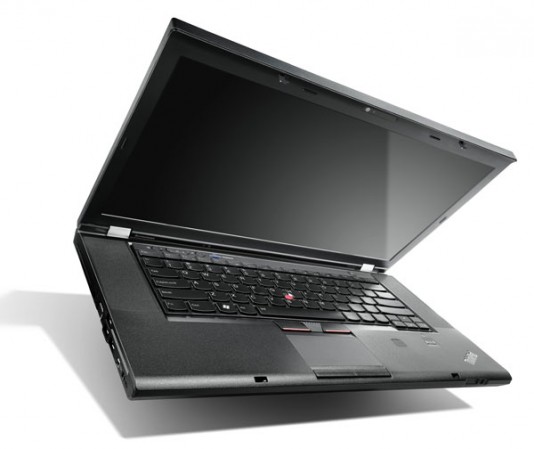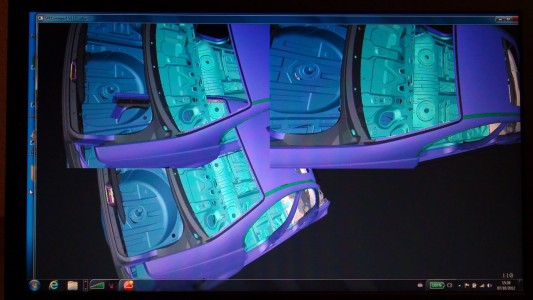Powerful performance options in a stylish package, plus tools for digital content creation make this a great computer.
By Tom Lansford
With additional comments by Randall S. Newton
[Editor’s Note: Contributing Writer Tom Lansford, Editor of CADplace.uk and CADplace.fr, and Managing Editor Randall Newton have both been working with a Lenovo ThinkPad W530 mobile workstation for a few weeks. What follows is Tom’s review, with added comments from Randall at the end.]
The Lenovo ThinkPad W530 is a solid, mid-sized mobile workstation light enough to comfortably take on the road. Lenovo’s latest mobile workstation has new CPU choices from Intel and the latest generation of Nvidia Quadro professional GPUs. And, of course, this workstation is certified with a host of professional applications as well.

At first glance you know it is a ThinkPad. The look, the feel, everything about this mobile workstation oozes “ThinkPad.” Lenovo remains consistent with their brand’s design. Perhaps more than any other workstation, the ThinkPad carries with it a particular image. Any reader familiar with the ThinkPad will look at the photos and will know how this notebook will feel in their hands.
This model boasts a host of new features and technologies starting with the newest, 3rd generation of Intel Core i5 and i7 CPUs and the latest Nvidia Quadro K Series of GPUs to deliver workstation performance and reliability. The W530 supports up to 32GB of memory to handle large projects. And you won’t have a problem storing all of your projects with a 1TB capacity hard drive.
I wasn’t the least surprised when I unpacked the matte black notebook. I was pleased to feel the solid design when I first opened the machine. It has a clean surface and is distinctly missing the “flimsy” feeling that makes one worry how much travel the display will withstand. You sense this machine will take the abuse that designers, engineers, and digital content professionals will inflict on it.

On the inside, the review unit came with an Intel Core i73520M CPU running at 2.9GHz and an Nvidia Quadro K1000 GPU. The ThinkStation has a 15.6 inch display. Lenovo supports a display resolution of 1600×900 in models with the Quadro K1000 GPU. The maximum resolution with a Quadro K2000 GPU is 1900×1080. On both review units, the notebook is running the 64 bit version of Windows 7 Professional, has 4GB of memory (maximum capacity is 32GB), and has 1TB storage capacity.
The ThinkPad connectivity gives what a workstation needs. A MiniDisplayPort (with audio) output as well as a VGA output. A combined headphone/microphone 3.5mm jack, 2 USB 3.0 ports and 2 UDB 2.0 ports, a 4-in-1 SD card reader, one express card, an Ethernet port, and a smart card reader. Lenovo can provide accessories for other interfaces such as a connection to a DVI monitor.


The keyboard is solid and responsive and a back-lit keyboard is available as an option. The touchpad has two sets of mouse buttons and a scroll-button. In addition there is the touch-button in the middle of the keyboard for customers who prefer it for navigation.
Security is provided with a number of features. The fingerprint reader is a security feature to prevent unauthorized access, as is a password for the BIOS. It has the Intel Anti-theft, Trusted Platform module and a smart card reader can be added to some models. Of course a Kensington Lock slot is available to secure the notebook physically.
It is a mobile workstation, and the 15.6 inch ThinkPad W530 won’t make you feel cramped while doing your job, and it won’t break your back carrying it through the airport or the train station.
Lenovo offers a variety of accessories for the ThinkPad W530, ranging from docking stations and display cable adapters to extra-capacity batteries, headphones, and a traveling, wide-screen mobile display.

Viewperf scores
For CAD and design professionals, workstation performance can be measured with the Viewperf benchmark, created and managed by Specbench.org. The test suite is designed to provide performance-comparison data for graphics workstations.
The data sets are designed on industry applications for engineering, architecture, and visualization like Catia, SolidWorks, Allplan, Lightwave, Siemens NX, Creo, etc. In addition to using representative datasets, the benchmarks are the results of collaboration and peer review within the industry. Therefore, comparative testing with Viewperf will provide good information on relative graphics performance for professional usage.
You will find a short history and overview of the benchmark in this article, “What is this thing called SPECviewperf?” The benchmark is free to download and use for any professional interested in evaluating the performance of their graphics workstations.
For application specific evaluation, the SPECbench organization also has application-level benchmarks for several leading applications in different professional domains. These are called the SPECapc benchmarks.
Our results for Viewperf on the Lenovo ThinkPad W530:
| Viewset | Composite | Comment |
| catia-03 | 22.11 | The catia-03 viewset was created from traces of the graphics workload generated by the Catia V5 R19 and Catia V6 R2009 applications from Dassault Systèmes. |
| ensight-04 | 11.66 | The ensight-04 viewset represents engineering and scientific visualization workloads created from traces of CEI’s EnSight 8.2 application. |
| lightwave-01 | 45.32 | The lightwave-01 viewset was created from traces of the graphics workloads generated by the SPECapc for Lightwave 9.6 benchmark. |
| maya-03 | 32.99 | The maya-03 viewset was created from traces of the graphics workload generated by the SPECapc for Maya 2009 benchmark. |
| proe-05 | 10.97 | The proe-05 viewset was created from traces of the graphics workload generated by the Pro/ENGINEER Wildfire™ 5.0 application from PTC. Model sizes range from 7- to 13-million vertices. |
| sw-02 | 30.54 | The sw-03 viewset was created from traces of the graphics workload generated by the SolidWorks 2009 SP2 application from Dassault Systèmes. |
| tcvis-02 | 21.95 | The tcvis-02 viewset is based on traces of the Siemens Teamcenter Visualization Mockup application (also known as VisMockup) used for visual simulation. Models range from 10- to 22-million vertices and incorporate vertex arrays and fixed-function lighting. |
| snx-01 | 17.20 | The snx-01 viewset is based on traces of the Siemens NX 7 application. The traces represent very large models containing between 11- and 62-million vertices, which are rendered in modes available in Siemens NX 7. |
I recommend some changes to the test configuration we received. The most obvious is to have 8GB or more memory. For any tasks beyond the most basic CAD work, consider at least 16GB of memory if not directly the maximum of 32GB.
The hard drive options are numerous. Supporting 1 TB of storage can be crucial for many professionals. If performance is the main criteria, Lenovo offers several options for SSD drives.

The Nvidia Quadro K1000 will do a good job on any mainstream CAD application. But if your work is the least bit graphics-intensive, it would be an easy decision to move to the Quadro K2000 and increase the display resolution to 1920×1080 at the same time.
The 2.9 GHz Intel Core i7 we tested is already one of the highest performance models offered in this mobile workstation and is an excellent choice for the CPU. This CPU can handle anything you are likely to throw at it. But Lenovo does offer you the choice to go even faster. If your work is computationally intensive with simulations or rendering tasks, then increase the CPU power. The most power you can put into this system is the Intel Core i7-3920XM Extreme Edition.
The ThinkPad W530 delivers a truly mobile, professional workstation. It is a 15.6 inch notebook which will let you take your work on the road, handle the abuse you might give it, and not break your back or make you buy an extra roll-bag just to be on-the-go.
Randall comments: I share Tom’s sentiments regarding the ThinkPad W530. A few extra notes:
Color calibration: My unit was equipped with an X-Rite electronic eye, an integrated color calibration tool. If you are picky about color, this is a marvelous addition well worth the added expense. The software that runs the calibration can be set to automatically remind the user to re-calibrate weekly, every two weeks, etc. In addition, the W530 can run up to four external displays.
Audio: The Dolby audio was a surprising addition; audio technology has been lacking in other mobile workstations I have seen recently. The speakers rival the MacBook Pro for quality.
Fingerprint recognition: My experience with the fingerprint reader for automated login was not satisfactory; sometimes it read my finger on the first try, other times I gave up after several attempts and typed in my password. My wife has a HP consumer notebook with a much better fingerprint reader.
Battery power: I have taken this workstation on several trips, including to Europe, and have used it to take notes for day-long meetings. The battery power is phenomenal for a mobile workstation—and I’ve used several over the years.
Touchpad: The touchpad is the best I have used in a long time. Firm without feeling the need to bang on it, and not overly sensitive—with other notebook computers I have used recently it seemed as if the touchpad would respond even if I only come close to touching it. The rippled texture is a nice change.
Security: An external on/off switch for WiFi is standard, and is a must for using a mobile computer in situations where security is a top priority.
Pop-up ad: Continual pop-up ads for Norton security software bugged me, and there was no straightforward way to stop them short of running the trial. I am pretty sure any buyer of a mobile workstation already has a preferred brand of security software and doesn’t need a trial from Norton or any other vendor.
Custom desktop: Like rivals HP and Dell, Lenovo offers a customized desktop experience. I have yet to find a compelling reason to use any of these alternatives.





